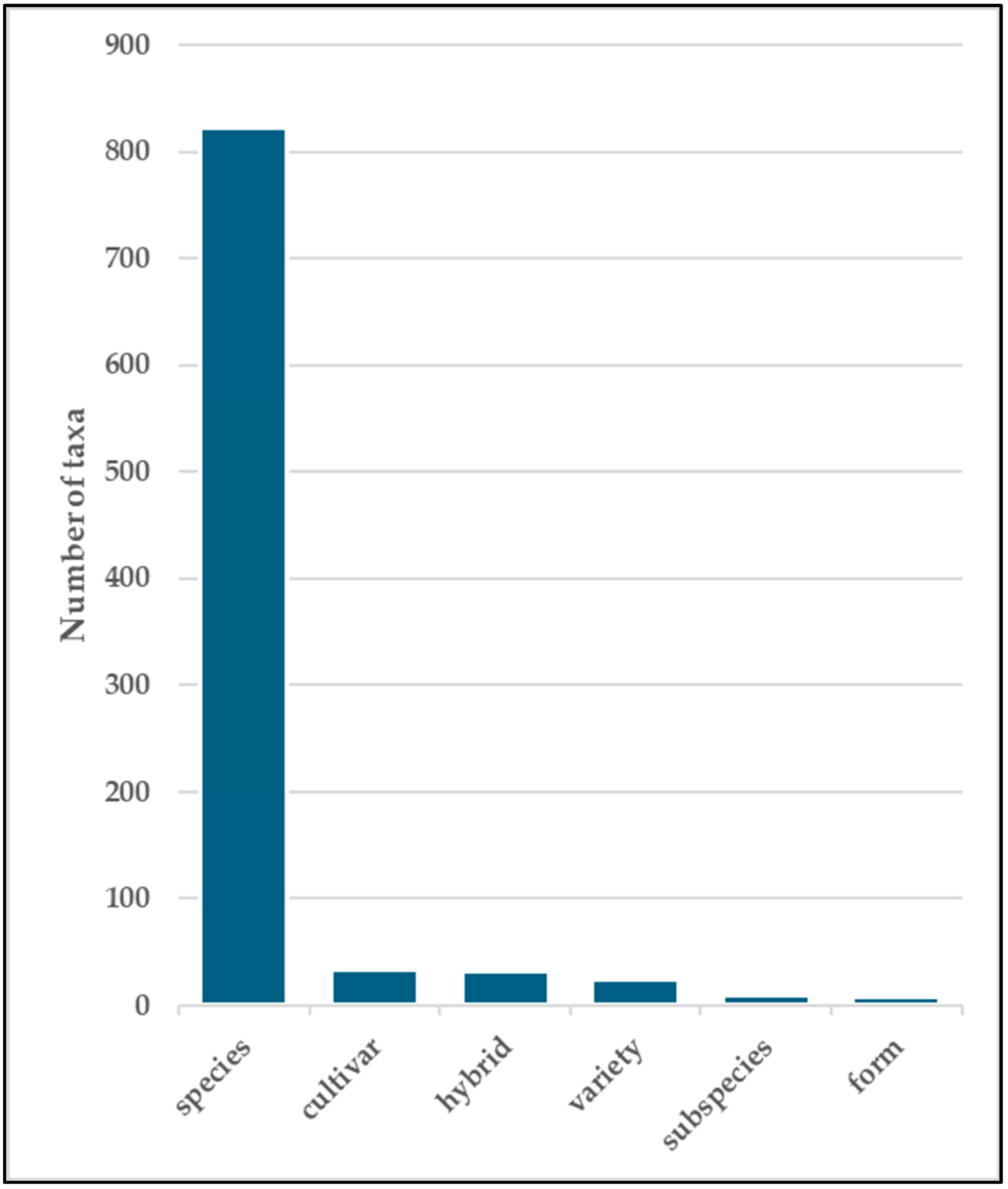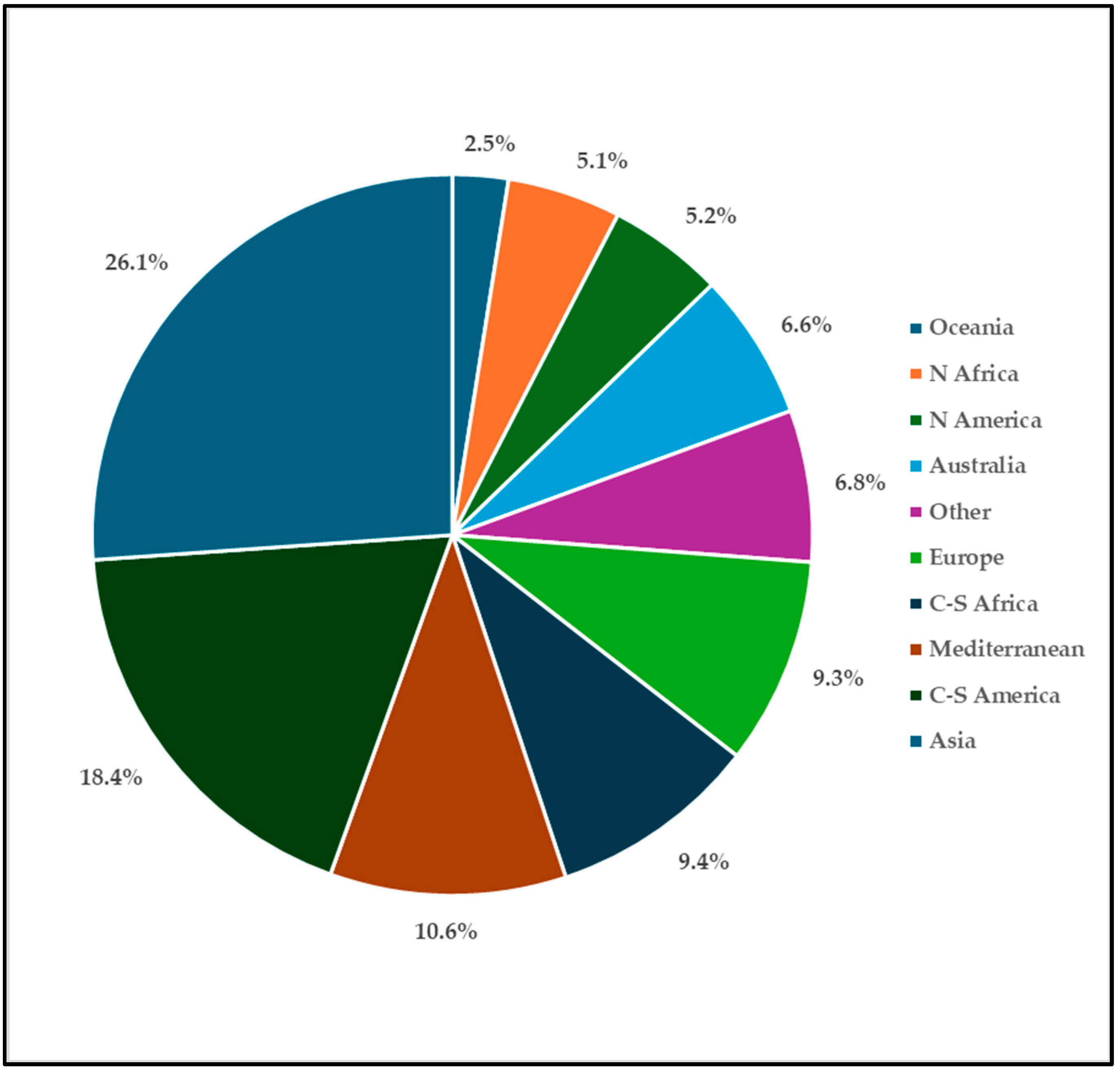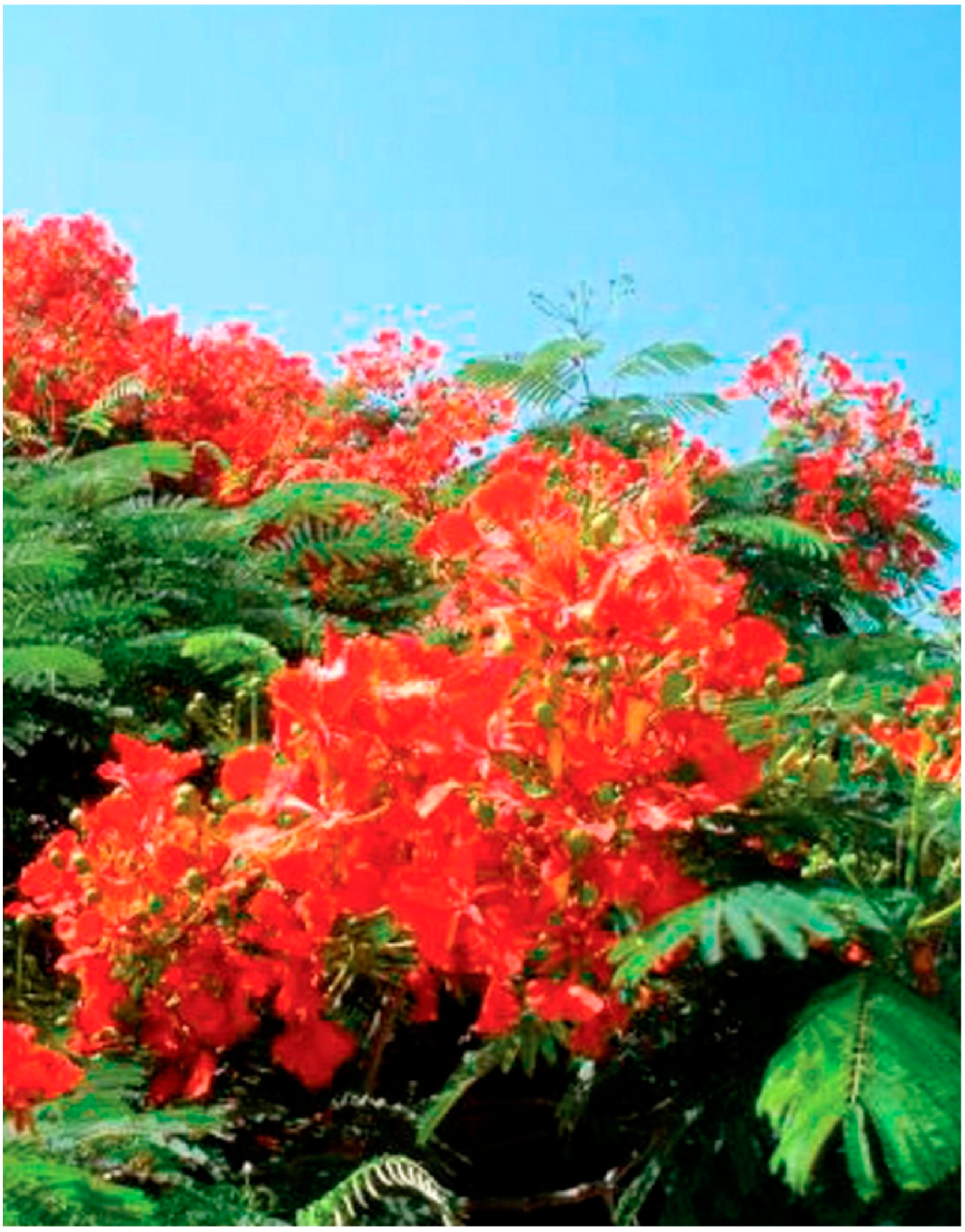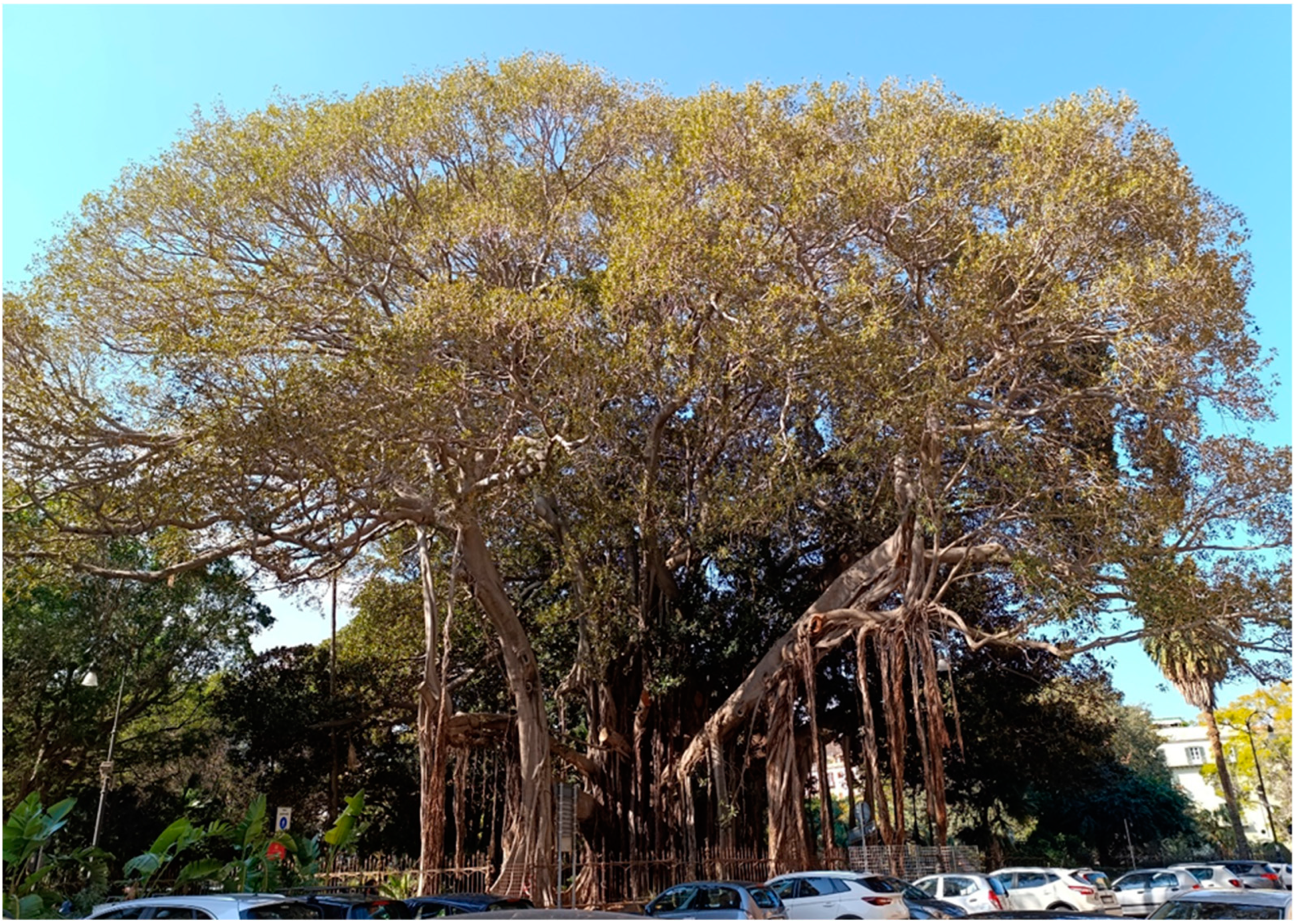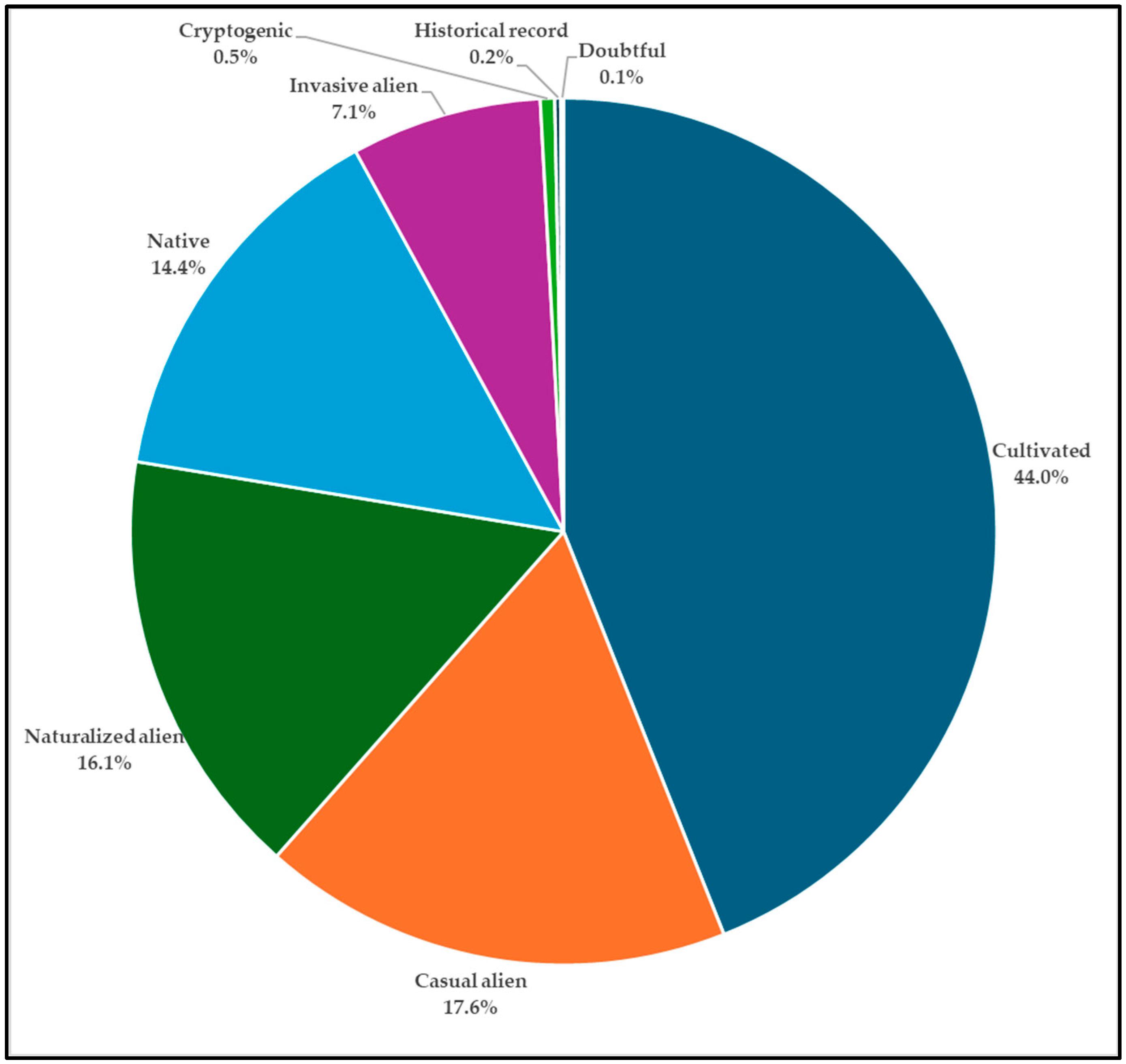1. Introduction
Currently, rapid urbanization, climate change, pollution, water shortages, and the decline of human well-being are challenges that cities need to address [
1]. To deal with such challenges, urban ecosystems must enhance the environmental services offered through green urban infrastructure. Usually, ornamental plants have been used as street trees in cities and in urban parks and gardens for their aesthetic beauty. Beyond that, ornamental plants represent significant living elements in urban settings and deliver many vital ecosystem services, such as climate regulation, air, and water cleaning, nutrient recycling, the creation of productive soil, pollination, and food for animals, but also cultural benefits like recreational opportunities and the inspiration for drawings from nature [
1,
2]. On the other hand, many ornamental plants are toxic and can also be responsible for allergies, so in planning and managing public and private green spaces, the potential risks to human health need to be carefully evaluated [
3]. Moreover, ornamental plants serve as a major source of alien plant invasions worldwide [
4]. The count of alien species is consistently and gradually increasing, and the occurrence of biological invasions is recognized to harm biodiversity, ecosystem services, human health, and the economy [
5,
6]. In this context, the case of
Ailanthus altissima (Mill.) Swingle is a very common example. Indeed, it is an exotic ornamental tree which represents a significant management challenge as it is both an invasive and allergenic species [
7]. Recent scientific studies highlighted the importance of recognizing the existence of alien species and the potential interactions they may have with native flora. The combined strategy for the management of non-native plant species highlights the need for multidisciplinary approaches to reduce adverse effects and promote a sustainable coexistence between native and alien species [
8]. Sicily, the largest island in the Mediterranean Basin, well known for its native and endemic flora, hosts a significant number of exotic ornamental plants. Since the Sicilian territory includes 11 bioclimatic zones ranging from the Infra-Mediterranean to the upper Cryo-Mediterranean [
9], the island can host taxa from different climates. The ornamental flora of Sicily has been investigated for over forty years. Several studies have dealt with the census of plants in historic parks and gardens, focusing attention not only on their taxonomic, chorological, and ecological characterization but also in relation to their spatial distribution and the type of gardens. The knowledge of this plant heritage, which for its characteristics has no equal in other regions of Italy, is of undoubted interest [
10]. A good part of the contributions published to date concern the ornamental flora of the city of Palermo, which is the Sicilian city with the largest number of historic parks and gardens. This is certainly due to the role of capital that the city itself had in the past; it was here that lived most of the members of the sumptuous nobility and wealthy Sicilian bourgeoisie who, especially from the beginning of the 19th century, began to enrich their villas with new plants inspired and certainly helped by the activities of the Palermo Botanical Garden. The study of Sicilian ornamental flora has not only concerned Palermo and its province but also other urban areas of western Sicily (Trapani and Agrigento) and eastern Sicily (Messina, Catania, Siracusa, and Ragusa) [
10]. Although an exhaustive inventory of ornamental taxa has recently been produced for Apulia (southern Italy) [
7], in other regions of Italy previous studies have been little concerned by the ornamental flora whereas many references addressing, more broadly, allochthonous or alien species can be found in publications and books [
11]. In this survey, we report a first contribution on the checklist of Sicilian ornamental vascular flora. To this end, the different floristic lists published so far have been gathered together and the literature data have been integrated with a large number of censuses conducted throughout the Sicilian territory.
2. Results
A total of 928 taxa, including 823 species s. str., 33 cultivar, 31 hybrids, 24 varieties, 9 subspecies, and 8 forms, are listed (
Figure 1). The recorded taxa belong to 486 genera of 138 families (
Table S1). A total of 8 taxa belong to the Pteridophyta, 61 to the Pinophyta, 5 to the Cycadophyta, 1 to the Ginkgophyta, and 853 to the Magnoliophyta (693 Magnoliopsida and 160 Liliopsida). The families with the highest number of specific and subspecific taxa are the following: Fabaceae (57 taxa, 6.1%), Rosaceae (43 taxa, 4.6%), Asteraceae (41 taxa, 4.4%), Cactaceae (40 taxa, 4.3%), Asparagaceae (37 taxa, 4.0%), Arecaceae (34 taxa, 3.7%), Malvaceae (32 taxa, 3.4%), Oleaceae (29 taxa, 3.1%), Solanaceae (26 taxa, 2.8%), Moraceae (24, taxa, 2.6%), Cupressaceae, Crassulaceae, and Myrtaceae (23 taxa, 2.5%), Euphorbiaceae (21 taxa, 2.3%), Pinaceae, and Asphodelaceae (20 taxa, 2.2%) (
Figure 2).
The most representative genera are Euphorbia and Ficus (19 taxa), Opuntia (14 taxa), Aloe (11 taxa), Agave and Eucalyptus (10 taxa), Citrus, Pinus, and Prunus (9 taxa), Jasminum, and Ligustrum (8 taxa).
The growth form spectrum (
Figure 3) shows a clear prevalence of phanerophytes (in particular the scapose and caespitose) which overall reach 703 taxa, accounting for 75.8%; geophytes (71 taxa, 7.7%), chamaephytes (52 taxa, 5.6%), nanophanerophytes (48 taxa, 5.2%), and hemicryptophytes (32 taxa, 3.4%). Lower percentage values are shown by therophytes (17 taxa, 1.8%) and hydrophytes (5 taxa, 0.5%).
The above percentage breakdown is due to the fact that trees, shrubs, and geophytes demand less cultivation care than other types of plants. Annuals, specifically, thrive primarily in private gardens, where the owners’ care and commitment are more significant. Likewise, aquatic plants are rarely seen, primarily because of the limited water resources and the high costs associated with their maintenance [
3]. Regarding the geographical origin (
Figure 4), the contingents with the greatest number of representatives are the Asian (26.1%), the American (5.2% North, and 18.4% Central and South America), and the African (14.5% of which 9.4% are from Southern Africa).
The Mediterranean contingent amounts to 10.6%, demonstrating a certain interest also in the use of native plants for decorative purposes. The flora of the European continent accounts to 9.3% and that of Oceania to 9.1% (mainly from Australia, 6.6%). Finally, 6.8% is represented by taxa of different origins: Pacific Islands, Atlantic Islands (Canary Islands, Azores), horticultural, and artificial hybrids. The most represented origin biome is the temperate (321 taxa, 34.6%); however, adding the data of the subtropical and tropical biomes (in total 536 taxa, 57.7%), most of the taxa come from warm climates. Only 134 taxa (14.0%) are native to Italy, while 786 taxa (85.0%) are allochthonous; the remaining eight taxa (1.0%) are included in the cryptogenic, historical record, and doubtful categories. Concerning the tendency of naturalization on the allochthonous taxa, 408 taxa (44.0%) are cultivated, 163 taxa (18.0%) are casual alien (i.e., they exhibit a trend towards naturalization yet do not form populations separate from the cultivated plants), 149 taxa (16.0%) are naturalized (i.e., they tend to form stable populations) and 66 taxa (7.0%) are invasive alien (i.e., they could pose a threat to biodiversity by competing with native species) (
Figure 5).
3. Discussion
Since the Sicilian territory includes a wide range of bioclimatic areas [
9], the island can host taxa originating from different climates. Indeed, in the mountainous or hilly areas (Madonie, Nebrodi, province of Enna, Etna volcano, Iblean Plateau, and Mounts Sicani) there are typical taxa from cooler climates such as
Abies alba Mill.,
A. cephalonica Loudon,
A.
nebrodensis (Lojac.) Mattei,
A.
pinsapo Boiss.,
Amelanchier laevis Wiegand,
Cedrus atlantica (Endl.) Manetti ex Carrière,
Cedrus deodara (Roxb. ex D. Don) G. Don,
C.
libani A. Rich.,
Picea abies (L.) H. Karst.,
P.
pungens Engelm.,
P.
smithiana (Willd.) Boiss.,
Sequoia sempervirens (D. Don) Endl., and
Taxus baccata L.. As for
Abies nebrodensis, it is an endemic species with limited distribution on the Madonie Mountains and at risk of extinction. Among the ex situ conservation actions proposed within LIFE projects (LIFE Natura and LIFE4FIR) the adoption of plants by local populations has been foreseen. This proposal, which was favorably received, has led to the widespread use of
A.
nebrodensis as an ornamental plant in recent times. Along the coasts of Sicily, where the climate is warmer, taxa of the subtropical and tropical flora prevail. This is certainly the floristic component that peculiarly characterizes the Sicilian ornamental flora. In fact, these taxa, planted in open air, manage to flower and bear fruit abundantly, arousing the wonder of foreigners visiting the island. Furthermore, several of these taxa, which in Sicily grow vigorously and luxuriantly, in the rest of Italy and Europe either do not survive or live with difficulty and rarely bloom. Under these conditions, lush gardens and magnificent villas arose in the coastal Sicilian cities, of such splendor and richness as to evoke an almost phantasmagorical impression of the tropics in the heart of the Mediterranean. In this sense, there are several taxa of high ornamental value, not only for the beauty of the flowering but also for the vegetative habitus, which now characterize the Sicilian coastal urban greenery. The survey of the Sicilian ornamental heritage revealed the presence of rare taxa both for the Sicilian context and for the Italian and Mediterranean one. Some of them are also relevant for their size, age, historical value, the role they play in the characterization of individual plants, and of relative contexts. These taxa, therefore, constitute real floristic and cultural peculiarities. The most significant ones are reported below as follows:
Acokanthera oppositifolia (Lam.) Codd,
Agathis robusta (C. Moore ex F. Muell.) F. M.Bailey,
Allocasuarina verticillata (Lam.) L. A. S.Johnson,
Aloidendron barberae (Dyer) Klopper and Gideon F. Sm.,
Alpinia zerumbet (Pers.) B. L. Burtt and R. M. Sm.,
Araucaria araucana (Molina) K. Koch,
A.
bidwillii Hook.,
A.
cunninghamii Mudie,
A.
rulei F. Muell.,
Bosea yervamora L.,
Brahea calcarea Liebm.,
B.
dulcis (Kunth) Mart.,
Butia yatay (Mart.) Becc.,
Calycanthus floridus L.,
Camphora officinarum Boerh. ex Fabr.,
Ceratozamia mexicana Brongn.,
Combretum indicum (L.) De Filipps,
Cordia francisci Ten.,
C.
myxa L.,
Corynocarpus laevigatus J. R. Forst. and G. Forst.,
Decaisnea fargesii Franch.,
Delonix regia (Bojer) Raf.,
Dracaena draco L.,
Ehretia tinifolia L.,
Elaeodendron australe Vent.,
Enterolobium contortisiliquum (Vell.) Morong,
Eriocephalus africanus L.,
Erythrina afra Thunb.,
Eucalyptus grandis W. Hill ex Maiden,
Euphorbia candelabrum Welw.,
E.
tirucalli L.,
E.
triangularis Desf. ex A. Berger,
Ficus altissima Blume,
F.
benghalensis L.,
F.
benjamina L.,
F.
elastica Roxb. ex Hornem var.
decora Guillaumin,
F.
lyrata Warb.,
F.
macrophylla Pers. f.
columnaris (C. Moore) D. J. Dixon,
F.
macrophylla f.
whitakeri Raimondo and Bajona,
F.
racemosa L.,
F.
virens Aiton,
Fontanesia philliraeoides Labill.,
Gardenia thunbergia Thunb.,
Halleria lucida L.,
Howea belmoreana (C. Moore and F. Muell.) Becc.,
Ipomoea alba L.,
Jacaranda mimosifolia D. Don,
Justicia adhatoda L.,
J.
spicigera Schltdl.,
Kleinia neriifolia Haw.,
Laurus azorica (Seub.) Franco,
Livistona decora (W. Bull) Dowe,
Mandevilla laxa (Ruiz and Pav.) Woodson,
Nolina parviflora (Kunth) Hemsl.,
Opuntia streptacantha Lem.,
O.
tomentosa Salm-Dyck,
Oreopanax nymphaeifolius (Hibberd) Decne. and Planch. ex G. Nicholson,
Osteomeles schweriniae C. K. Schneid.,
Pararchidendron pruinosum (Benth.) I. C. Nielsen,
Phoenix loureiroi Kunth,
P.
rupicola T. Anderson,
Photinia davidiana (Decne.) Cardot,
Picea pungens Engelm. ‘Glauca’,
P.
smithiana (Willd.) Boiss.,
Pisoniella arborescens (Lag. and Rodr.) Standl.,
Pittosporum undulatum Vent.,
Plumeria rubra L.,
Podocarpus neriifolius D. Don,
Portulacaria afra Jacq.,
Puya ×
berteroniana Mez,
Quercus polymorpha Schltdl. and Cham.,
Searsia lancea (L. f.) F. A. Barkley,
Sequoia sempervirens (D. Don) Endl.,
Sparrmannia africana L. f.,
Thuja plicata Donn ex D. Don,
Thunbergia coccinea Wall. ex D. Don,
Xanthoceras sorbifolium Bunge,
X.
preissii Endl.,
Yucca faxoniana (Trel.) Sarg., and
Zamia furfuracea L. f. ex Aiton. Among the above-mentioned taxa,
Delonix regia,
Ficus macrophylla f.
columnaris, and
Plumeria rubra deserve a special mention.
Delonix regia is an evergreen tree native to Madagascar, among the most spectacular and ornamental in the world. It is known as ‘flamboyant’, for the showy red bloom that covers its large crown. In Sicily, an adult individual (
Figure 6) capable of flowering and fruiting is found in a small private garden in the urban center of Donnalucata (Ragusa); two other young plants, not yet flowering, are found in Scoglitti and Marina di Ragusa (Ragusa). These are the only documented reports of the species being cultivated in open air conditions in both Sicily and Italy [
16].
F.
macrophylla f.
columnaris is a majestic tree native to the Lord Howe Islands (Australia), very distinctive for its particular shape. It has a large, branched crown with numerous bundles of hanging aerial roots that, once they reach the ground, grow, intertwining and joining together to form columnar roots that serve to support the large branches. In nature, it first grows as an epiphyte on other trees which it then suffocates by developing a powerful network of branches, and aerial and tabular roots to support its monumental crown. In Palermo, there are several monumental individuals, especially those of Villa Garibaldi (
Figure 7) and the Botanical Garden, which are considered, for the development of the crown and volume, the largest trees in Europe [
17].
Plumeria rubra, also known as ‘frangipani’, is a small Caribbean tree of great ornamental value due to its beautiful and fragrant flowers of different colors and forms [
18]. In Hawaii, its flowers are traditionally used for the famous flower necklaces (Lei), which have become a symbol of brotherhood and hospitality. In Sicily, the species is cultivated along the coastal areas, especially in Palermo (
Figure 8), where it has been renamed ‘pomelia’. Upon its introduction in Palermo, the plant was instantly valued for the stunning beauty and strong fragrance of its flowers, leading to its rapid proliferation in both private and public gardens, and its cultivation in pots on balconies and terraces, ultimately becoming a symbol of the city’s floral exhibitions. In Palermo,
P. rubra serves not only an ornamental purpose but also holds deep cultural importance. It is a sign of fertility developed by comparison with the extraordinary strength of the plant’s vegetative power. Consequently, the white flowers are frequently utilized in the bouquets of brides in Palermo, and traditionally, the bride moving to a new home receives a plant from her mother as a gesture for family continuity [
19].
Based on floristic surveys reported in the existing literature [
10,
20,
21,
22,
23,
24,
25,
26,
27,
28,
29,
30,
31,
32,
33,
34,
35], our field investigations have identified 63 unpublished taxa (6.8%). Among these, the following genera
Abelia,
Acanthus,
Alyogyne,
Annona,
Archontophoenix,
Asclepias,
Astrophytum,
Cochliasanthus,
Deuterocohnia,
Eremophila,
Eschscholzia,
Euryops,
Gunnera,
Hardenbergia,
Harpephyllum,
Kumara,
Liquidambar,
Loropetalum,
Pachira,
Pachypodium,
Phlomis,
Pyrostegia,
Rhapis,
Roystonea,
Saccharum,
Sesbania,
Symphoricarpos,
Talinum,
Weigela, and
Zamia are reported for the first time in Sicily. These newly recorded plants contribute to further diversifying the Sicilian ornamental flora.
Common in the Sicilian gardens is the utilization of plants that offer both decorative value and productivity. Among the ornamental taxa found in this study that also have nutritional importance we should mention the following: Annona cherimola Mill., Carica papaya L., Carya illinoinensis (Wangenh.) K. Koch, Casimiroa edulis La Llave, Citrus japonica Thunb., C. reticulata Blanco, C. ×aurantium L., C. ×aurantium f. aurantium, C. ×limon (L.) Osbeck, Corylus avellana L., Diospyros kaki Thunb., Feijoa sellowiana (O. Berg) O. Berg, Juglans regia L., Musa ×paradisiaca L., Persea americana Mill., Punica granatum L., Prunus armeniaca L., P. domestica L., P. dulcis (Mill.) D. A. Webb, P. persica (L.) Batsch, Saccharum officinarum L., and Vitis vinifera L. The most important medicinal plants are Aloe arborescens Mill., A. arborescens var. frutescens (Salm-Dyck) Link, and Aloe vera L. In addition to their ornamental, productive, and medicinal roles, these taxa could be strategically used in public urban areas for educational activities, particularly in schools, where hands-on learning about plant cultivation, local biodiversity, and nutrition can be integrated into their studies. Furthermore, they hold potential for short-scale feeding initiatives aimed at children or individuals in need by providing a supplementary source of fresh produce. This approach not only enhances environmental awareness but also fosters social benefits through the intersection of aesthetics, education, and locally oriented food supplies.
On the contrary, many of the taxa found in Sicilian ornamental flora have a negative impact on human health and it is desirable to advise against their use in new gardens. The best-known ornamental genera and plants considered responsible for pollinosis and commonly used in Sicily, especially in urban areas, are
Cupressus spp.,
Hesperocyparis spp.,
Pinus spp.,
Ailanthus altissima,
Olea europaea L.,
Quercus ilex L., and
Populus sp. pl. Stinging hairs inside the fruits of
Brachychiton spp. and
Lagunaria patersonia (Andrews) G. Don are dangerous for the mucous membranes of the eyes and mouth; in the genera
Ficus and
Plumeria, the latex is irritating [
3]. Also, a wide number of ornamental Sicilian taxa are poisonous such as
Brugmansia arborea (L.) Sweet,
Cascabela thevetia (L.) Lippold,
Digitalis purpurea L.,
Drimia pancration (Steinh.) J. C. Manning and Goldblatt,
Laburnum anagyroides Medik.,
Melia azedarach L.,
Nerium oleander L.,
Nicotiana glauca Graham,
Ricinus communis L.,
Tagetes erecta L.,
Taxus baccata L., and
Thuja occidentalis L. The species selected for ornamental greenery, in principle, ought to pose no harmful effects on human health or on pets, yet attaining this outcome is challenging [
3]. In fact, in many cases, decisions made by municipal administrations about ornamental plants are influenced by the visual appeal of the plants and their accessibility in garden centers. However, when planning and supervising public and private green spaces, the potential risks that plants may pose to the health of humans and pets must be considered. To this end, it would be desirable for administrators to avail themselves of the professional support of botanists to adequately guide their choices regarding urban greenery with particular reference to the health of their inhabitants [
7]. Furthermore, it could be beneficial for municipal administrators to label noxious or toxic plants that are in public spaces, ensuring that both residents and visitors (especially children) are aware of the potential risks. These efforts may be complemented by educational programs at schools, where students can learn about plant identification, safe handling, and responsible interaction with greenery. In this way, communities not only minimize health hazards but also foster an informed appreciation of urban flora and the importance of biodiversity.
Finally, this survey illustrates the continuous increase of alien species in the flora of Sicily: a widespread pattern observed worldwide. The overwhelming presence (as much as 85.0%) of allochthonous ornamental taxa compared to native species is another important data point to evaluate the role of such plants used as ornamentals, especially when it comes to aliens that are potentially harmful to human health that escape cultivation and tend to form stable populations. This is the case, for example, of Cascabela thevetia and Melia azedarach, valuable ornamentals but also deadly poisonous plants that have become naturalized in Sicily. These plants, along with their seeds, are easily available at nurseries and shops. All of this should serve as an additional warning about biological invasions that continue to encounter inadequate containing measures to halt their spread. In instances where such species pose a critical threat, e.g., Acacia saligna (Labill.) H. L. Wendl., Ailanthus altissima, Carpobrotus acinaciformis (L.) L. Bolus, C. edulis (L.) N.E.Br., Opuntia ficus-indica (L.) Mill., Parkinsonia aculeata L., Robinia pseudoacacia L., and Vachellia karroo (Hayne) Banfi and Galasso, removal programs may be necessary. In less urgent cases, targeted management actions should be considered to limit their establishment and expansion.
Nonetheless, thanks to the financing from the National Recovery and Resilience Plan (NRRP), the issue of invasive species has re-emerged on the agenda and efforts are underway to raise awareness of the dangers associated with the introduction and spread of non-native invasive species, and to emphasize the best practices in both production and gardening to mitigate the risk [
7].
To the best of our knowledge, our inventory, comprising 928 taxa, currently represents the most complete contribution to the Italian ornamental flora at the regional level. Recently, a similar approach was used to produce a comprehensive inventory for the Apulia region [
7], which documented a total of 287 taxa across 179 genera and 78 families. Comparing the results of the two inventories (Sicily and Apulia), we found that 251 taxa were present in both regions, while 36 of the resulted taxa were only present in Apulia. Among these, noteworthy taxa unique to Apulia include
Cupressus cashmeriana Royle ex Carrière,
Ficus maclellandii King,
Pyrus calleryana Decne.,
Quercus ithaburensis subsp.
macrolepis (Kotschy) Hedge and Yalt., and
Quercus trojana Webb.
